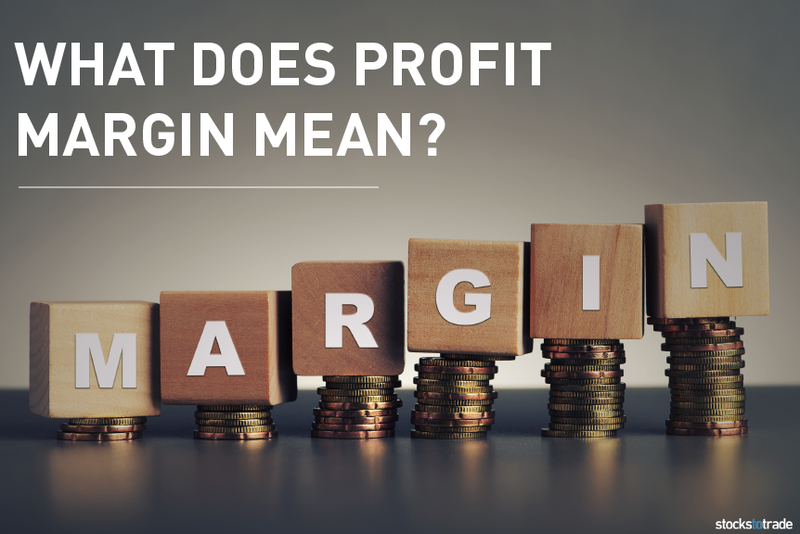Table of Contents
As a trader, it’s not hard to find potential stocks to trade — there are literally thousands to choose from. What can be challenging, however, is narrowing your choices to the best contenders.
Calculating a company’s profit margin can be a great way to cull the selections on your stock watchlist. Profit margin is a ratio that can give you some great insight into the company’s profitability and overall health.
This post offers an educational overview of what profit margin means, how to calculate it, and how you can use this information to your trading advantage.
What Is Profit Margin?
Download the key points of this post as PDF.
The profit margin is a ratio that tells you the portion of a company’s income that is profit.
This data is shown as a percentage, which tells you how much a company keeps out of its actual earnings. So, for instance, if a company has a 30 percent profit margin, this means that they make 30 cents per every dollar earned.
The most basic and most common profit margin calculation is the net margin, which is often used interchangeably with the term profit margin.
While it’s worth noting that there are different ways that it can be calculated, including operating margin, gross profit margin, and pretax profit margin, in this post we’ll focus on the net profit margin.
How is profit margin calculated?
The good news: Calculating the profit margin is easy.
First, you need to determine the net income or net profit. You can do this by subtracting the company’s costs (raw materials, taxes, operating, etc) from the net sales.
So, if the company had net sales of $1 million but had costs of $700,000, the net income would be $300,000.
Then, you’ll calculate a percentage by dividing the net income by the net sales. So, if your net income is $1 million, then you calculate it as a 30 percent profit margin.
To put that in an easy-to-wrap little package:
Net income / net sales = profit margin
What Can You Learn From the Profit Margin?
Once you’ve calculated a company’s profit margin, what takeaways can you apply to your trades? Here’s the deal …
The profit margin helps you gain insight into the company’s profitability. While a company’s net sales might be huge, if the company has a low-profit margin, their earnings might not be as impressive overall.
It doesn’t just matter how much a company makes — it matters what percentage of those earnings are profit.
Just to be clear, there’s no specific percentage of profit margin that equals trouble within a company. After all, certain industries might generally be prone to having lower profit margins.
However, a low profit margin is typically not desirable. Here’s why:
- Less stability. A decrease in sales or an increase in the cost of raw materials could even further decline a company’s profitability.
- It could be a sign of bad management. If a company’s profit margin is low, it could be a sign that the company may not be operating as effectively as possible, due to things like poor management or allocation of funds.
- They may not be charging appropriately. The profit margin can indicate how appropriately the company is pricing their products or services. For instance, a low profit margin might be an indication that they aren’t charging enough.
- It could be an industry-wide problem. Low-profit margins can tell you something about the sector in which the company operates. It could mean that this sector is suffering or in decline.
The profit margin is a general indicator that can tell you about the company’s overall health. A company’s profit margin can give you a glimpse at how the company is doing.
Considerations
Profit margin can be a helpful calculation and ratio to consider as part of your fundamental stock research. However, it doesn’t tell you the full story. So keep these considerations in mind:
- Consider comparables. Average profit margins can differ quite wildly depending on the industry. So don’t just look at the number — compare it to similar companies within the same industry.
For example, a successful pharmaceutical company and a successful luxury goods company might have very different profit margins.
Because of this, when you’re comparing companies, only use the profit margin to compare within the same industry. For example: Compare Tiffany and Cartier, but don’t compare Tiffany and Johnson & Johnson.
- The current economy matters. If you’re calculating the profit margin for a company or sector that’s currently losing money, the calculation might not be very helpful.
After all, you already know that this company or industry is hurting, so you’re not going to gain any big insight from calculating the profit margin.
- You need more information. Like any other metric or calculation, the profit margin only tells a small portion of a company’s story.
For this reason, it should only be one of many calculations that you use as part of your stock research, which ideally should include both extensive fundamental and technical research.
StocksToTrade can help you sift through important technical data like stock volume and the biggest gainers and losers.
Bottom line: Profit margin is a tool that can help you choose stocks to trade — it’s well worth including in your stock research. However, it should never be used as the final deciding factor, because there are many other things to consider when choosing a stock, including the industry sector and current economy.
